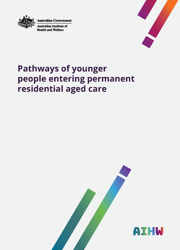Summary
Younger people living in permanent residential aged care have one thing in common—they are aged under 65—but beyond this, they can have a range of health conditions and care needs. Some younger people using aged care are people with a disability, but there is no direct way to identify this group in the administrative data, or the reasons people have for entering (or staying in) permanent residential aged care. However, people’s activity limitations, care needs and health conditions can provide some context. This report describes some of these characteristics and the patterns of aged care use for people who first entered permanent residential aged care at a younger age.
The number of younger people entering care has been steady over time
In each year between 2009–10 and 2013–14, around 2,000 people aged under 65 first entered permanent residential aged care. Around half of them were ‘older’ younger people (aged 60–64). Among the youngest age group (aged under 50), more than 1 in 10 were Indigenous. The overall number of younger people living in permanent care also remained steady through this time: in any year between 2010 and 2014, there were around 6,000 younger people in permanent residential aged care, with a median age of 60.
Around 1 in 4 younger people had an activity limitation in all 4 core activities
Activity limitations—particularly in the core activities of self-care, communication, movement between locations and moving/walking around—are a common way of measuring disability. Most (90%) younger people had an activity limitation in self-care, meaning that they had difficulty with daily tasks such as eating and getting dressed and needed another person’s supervision or help. More than 23% of younger people had an activity limitation in all 4 core activities; however, this varied depending on their first-listed or ‘main’ health condition. The top 3 main health conditions were dementia, cancer and cerebrovascular disease. Dementia was relatively less common among the youngest age group; instead, this group had other progressive neurological conditions.
Most younger people had simple pathways to permanent residential aged care
Almost 1 in 4 younger people who entered permanent care in 2009–10 to 2013–14 had not used any other aged care beforehand. Of those who had used care, the most common program was the entry-level Home and Community Care (HACC).
Time spent living in permanent residential aged care varied considerably
More than 20% of younger people who first entered permanent residential aged care in any year between 2009–10 and 2013–14 spent under 6 months in care. On the other hand, almost 40% of younger people who entered care in 2013–14 were still living in care at 30 June 2018.
1 Introduction
- Pathways in Aged Care link map
- Taking a long view
2 Younger people’s characteristics
- Circumstances at assessment
- Functional status and health conditions
3 Patterns of prior aged care use
- Pathways
- Time between assessment and entry
4 First episode of care
- Assessment in care
- Exits from care
5 Total length of stay in permanent care
- Time in care after first entry
- Time in care to 30 June
- Time in care before death
Appendix: Methodology and data quality
End matter: Acknowledgments; Abbreviations; Symbols; References; List of tables; List of figures; Related publications



